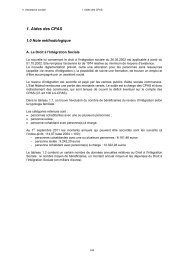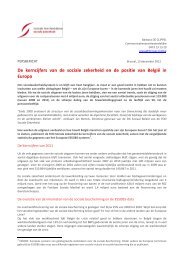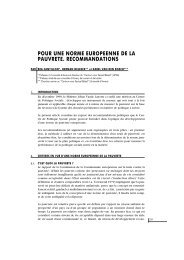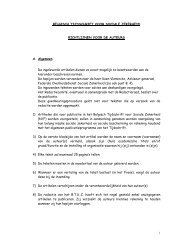social security - FOD Sociale Zekerheid
social security - FOD Sociale Zekerheid
social security - FOD Sociale Zekerheid
- No tags were found...
You also want an ePaper? Increase the reach of your titles
YUMPU automatically turns print PDFs into web optimized ePapers that Google loves.
B. Types of medical careMedical care covers both preventive and curative care required for maintaining and repairing aperson's health. Medical care is divided into 27 different categories of medical dispensations,the most important of which are:a) ordinary medical care, among others visits and consultations of general practitioners andspecialised practitioners and the care provided by physiotherapists;b) dental care;c) deliveries;d) dispensation of pharmaceutical products (chemist's preparations, pharmaceuticalspecialities, generic drugs, …);e) hospital care;f) care required for revalidation.All the medical dispensations that can be (partly or completely) reimbursed are listed ina so-called nomenclature of medical dispensations. The nomenclature is a list which doesnot only mention the relative value of dispensations, but also specific rules of application,requirements about the competence of care providers, etc. There is also a list with pharmaceuticalspecialities that are reimbursed.Just like salaried workers and civil servants, self-employed persons are entitled to medical care aswell, which includes the “small risks” since 2008.C. Reimbursement ratesC.1. Medical treatmentIf you go to a doctor or receive other medical treatment, you first have to pay the full amountin exchange for a medical receipt or certificate. Then, you take the certificate to your insuranceinstitution (health insurance fund), which partly refunds you.The insurance refund in the cost of medical treatment varies primarily with the nature of thetreatment, the status of the insured and the care provider's capacity. In most cases, the amountis not refunded entirely. Often, you have to pay a sum yourself, called personal fee or patientfee. Generally, the personal fee or patient fee amounts to 25%, but it may be higher or lowerdepending of the type of treatment.However, there are different ways to obtain a scheme of higher reimbursements for medicalcare for certain categories of persons. This scheme is known under different names, as the ruleshave changed through the years: "preferential scheme", "WIGW/VIPO status", "RVV/BIM status"or "OMNIO status".First way : on the basis of a granted <strong>social</strong> benefit (RVV/BIM status):42- Persons entitled to an integration income from the Public <strong>social</strong> welfare centre- Persons entitled to similar aid from the Public <strong>social</strong> welfare centre- Persons receiving the income guarantee for the elderly, persons receiving the guaranteedincome for the elderly or persons conserving the entitlement to the annuity bonus
















